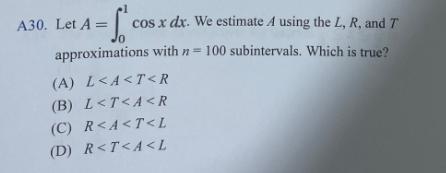Full solution
Q. Let . We estimate using the , , and approximations with subintervals. Which is true?(A) (B) (C) (D)
- Understand Approximations: Let's first understand what , , and approximations are. The Left () approximation sums up the values of the function at the left endpoints of the subintervals, the Right () approximation sums up the values of the function at the right endpoints, and the Trapezoidal () approximation averages the left and right approximations. Since is decreasing on the interval , we know that the Left approximation will overestimate and the Right approximation will underestimate the actual integral value. The Trapezoidal approximation, being an average of and , should lie between them.
- Calculate Left Approximation: We can calculate the Left approximation by summing the values of at the left endpoints of the subintervals. Since is decreasing on , will be an overestimate.
- Calculate Right Approximation: Similarly, we calculate the Right approximation by summing the values of at the right endpoints of the subintervals. Since is decreasing on , will be an underestimate.
- Calculate Trapezoidal Approximation: The Trapezoidal approximation is the average of and . Since is an overestimate and is an underestimate, should be closer to the actual value than either or .
- Compare Approximations: Now, we can compare the approximations. Since is decreasing on , we have R < A < L. The Trapezoidal approximation should be between and , so we have R < T < L. Combining these, we get R < T < A < L.

